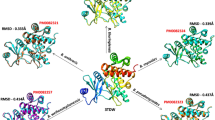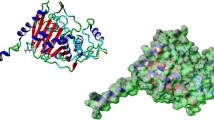Abstract
The resistivity of plant pathogen Erwinia amylovora against the polymyxin group of antibiotics is enhanced by modification of lipid A from lipopolysaccharide with 4-amino-4-deoxy L-arabinose (Ara4N) catalyzed by a bifunctional protein ArnA. ArnA is the first enzyme in the lipid A modification pathway with distinct dehydrogenase and transformylase domains which has been known in development of resistivity to polymyxin group of antibiotics. Thus, three dimensional structure of ArnA protein from Erwinia amylovora was constructed using homology modeling technique. The quality and reliability of the generated 3-D model was then assessed by different online available programs such as What if, PROCHECK, QMEAN, ProSA along with superimposition by UCSF Chimera. Sequence analysis study of ArnA protein from E. coli, Erwinia amylovora, Yersinia pestis, Ps. aeruginosa and Salmonella showed conserved domains with exact active site residues. Molecular docking study of ArnA protein with substrate UDP-GlcA and different inhibitors such as 5-formyl-5,6,7,8 tetrahydrofolate, leucovorin and 5-methyl tetrahydrofolate revealed similar binding pocket. The residues ASN492, ARG510, SER433 and ARG619 of ArnA protein are involved in interactions with inhibitors. Thus, this study could be useful to understand the proper binding mode of inhibitors to inhibit the lipid A modification pathway of ArnA protein from plant pathogen Erwinia amylovora.




Similar content being viewed by others
Abbreviations
- BLAST:
-
Basic local alignment search tool
- NCBI:
-
National centre for biotechnology information
- PDB:
-
Protein data bank
- RMSD:
-
Root mean square deviation
- SDF:
-
Structure data file
- UDP-GlcA:
-
Uridine-di-phosphate glucoronic acid
References
Altschul SF, Gish W, Miller W, Myers EW, Lipman DJ (1990) Blast - Basic local alignment search tool. J Mol Biol 215:403–410
Barage SH, Sonawane KD (2013) Exploring mode of phosphoramidon and Aβ peptide binding to hECE-1 by molecular dynamics and docking studies. Protein Pept Lett 21:140–152
Barage SH, Jalkute CB, Dhanavade MJ, Sonawane KD (2013) Virtual screening and molecular dynamics simulation study of hECE-1 protease inhibitors. Res J Pharm Biol Chem 4:1279–1291
Benkert P, Biasini M, Schwede T (2011) Towards the estimation of the absolute quality of individual protein structure models. Bioinformatics 27:343–350
Boyle N, Banck M, James C, Morley C, Vandermeersch T, Hutchinson G (2011) Open babel: an open chemical toolbox. J Chem Inform 3:33
Breazeale SD, Ribeiro AA, McClerren AL, Raetz CRH (2005) A formyltransferase required for polymyxin resistance in Escherichia coli and the modification of lipid A with 4-Amino-4-deoxy-L-arabinose. Identification and function of UDP-4- deoxy-4- formamido-L-arabinose. J Biol Chem 280:14154–14167
Dhanavade MJ, Sonawane KD (2014) Insights into the molecular interactions between aminopeptidase and amyloid beta peptide using molecular modeling techniques. Amino Acids 46:1853–66
Dhanavade MJ, Jalkute CB, Barage SH, Sonawane KD (2013) Homology modeling, molecular docking and MD simulation studies to investigate role of cysteine protease from Xanthomonas campestris in degradation of Aß peptide. Comput Biol Med 43:2063–70
Duffy B, Scharer HJ, Bünter M, Klay A, Holliger E (2005) Regulatory measures against Erwinia amylovora in Switzerland. EPPO 35:239–244
Duhovny D, Nussian R, Wolfson HJ (2002) In Guigo R, Gusfield, D. Proceedings of the fourth international Workshop on Algorithms in Bioinformatics. Springer- Verlag GmbH Rome, Italy 2452:185–200
Gatzeva-Topalova PZ, May AP, Sousa MC (2004) Crystal structure of Escherichia coli ArnA (Pmrl) decarboxylase domain. A key enzyme for lipid A modification with 4-amino-4-deoxy-L- arabinose and polymyxin resistance. Biochemistry 43:13370–13379
Graham DC (1964) Taxonomy of soft rot coliform bacteria. Annu Rev Phytopathol 2:13–18
Jalkute CB, Barage SH, Dhanavade MJ, Sonawane KD (2013) Molecular dynamics simulation and molecular docking studies of Angiotensin converting enzyme with inhibitor lisinopril and amyloid Beta peptide. Protein J 32:356–64
Jalkute CB, Barage SH, Dhanavade MJ, Sonawane KD (2014) Identification of angiotensin converting enzyme inhibitor: an In Silico perspective. Int J Pep Res Ther. doi:10.1007/s10989-014-9434-8
Jones DT (1999) Protein secondary structure prediction based on position- specific scoring matrices. J Biol Chem 292:195–200
Khan MA, Zhao Y, Korban SS (2012) Molecular mechanisms of pathogenesis and resistance to the bacterial pathogen Erwinia amylovora, causal agent of fire blight disease in Rosaceae. Plant Mol Biol Report 30:247–260
Laskowaski RA, MacArthur MW, Moss DS, Thorrnton JM (1993) PROCHECK: a program to check the stereochemical quality of protein. J Appl Cryst 26:283–291
McGhee GC, Sundin GW (2011) Evaluation of kasugamycin for fireblight management, effect on nontarget bacteria, and assessment of ksugamycin resistance potential in Erwinia amylovora. Phytopathology 101:192–204
Michalopoulos A, Falagas ME (2008) Colistin and Polymyxin B in critical care. Crit Care Clin 24:377–391
Moline HE, Johnson KS, Anderson JD (1983) Evaluation of two-dimensional polyacrylamide gel electrophoresis of acidic proteins of ribosome preparations for identifying plant pathogenic soft-rotting bacteria. Phytopathology 73:224–227
Moriarity JL, Hurt KJ, Resnick AC, Storm PB, Laroy W, Schnaar RL, Snyder SH (2002) UDP-glucuronate decarboxylase, a key enzyme in proteoglycan synthesis: cloning, characterization, and localization. J Biol Chem 277:16968–75
Morris GM, Huey R, Lindstrom W, Sanner MF, Belew RK, Goodsell DS, Olson AJ (2009) AutoDock4 and AutoDock Tools4: automated docking with selective receptor flexibility. J Comput Chem 30:2785–2791
Parulekar RS, Barage SH, Jalkute CB, Dhanavade MJ, Fandilolu PM, Sonawane KD (2013) Homology modeling, molecular docking and DNA binding studies of nucleotide excision repair UvrC protein from M.tuberculosis. Protein J 32:467–476
Petia Gatzeva-Topalova Z, Andrew May P, Marcelo Sousa C (2005) Structure and mechanism of ArnA: conformational change implies ordered dehydrogenase mechanism in key enzyme for polymyxin resistance. Structure 13:929–942
Pettersen EF, Goddard TD, Huang CC, Couch GS, Greenblatt DM, Meng EC, Ferrin TE (2004) UCSF chimera - a visualization system for exploratory research and analysis. J Comput Chem 25:1605–1612
Ramachandran GN, Ramakrishnan C, Sasisekharan V (1963) Stereochemistry of polypeptide chain configurations. J Mol Biol 7:95–9
Rezzonico F, Stockwell VO, Duffy B (2009) Plant agricultural streptomycin formulations do not carry antibiotic resistance genes. Antimicrob Agents Chemother 53:3173–3177
Sali A, Blundell TL (1993) Comparative protein modeling by satisfaction of spatial restraints. J Mol Biol 234:779–815
Steinberger EM, Beer SV (1988) Creation and complementation of pathogenicity mutants of Erwinia amylovora. Mol Plant-Microbe Interact 3:135–144
Tenover FC (2006) Mechanisms of antimicrobial resistance in bacteria. Am J Med 119:S3–S10
Thompson JD, Gibson TJ, Plewniak F, Jeanmougin F, Higgins DG (1997) The CLUSTAL_X windows interface: flexible strategies for multiple sequence alignment aided by quality analysis tool. Nucleic Acids Res 25:4876–4882
Trent MS, Ribeiro AA, Lin S, Cotter RJ, Raetz CR (2001) An inner membrane enzyme in Salmonella and Escherichia coli that transfers 4-amino-4-deoxy-L- arabinose to lipid A: induction on polymyxin-resistant mutants and role of a novel lipid- linked donor. J Biol Chem 276:43122–43131
Tseng GN, Sonawane KD, Korolkova YV, Zhang M, Liu J, Grishin EV, Guy HR (2007) Probing the outer mouth structure of the HERG channel with peptide toxin footprinting and molecular modeling. Biophys J 92:3524–40
Vaara M (1992) Agents that increase the permeability of the outer membrane. Microbiol Rev 56:395–411
Vriend G (1990) WHAT IF: a molecular modeling and drug design program. J Mol Graph 8:52–56
Wiederstein M, Sippl MJ (2007) ProSA-web: interactive web service for the recognition of errors in three- dimensional structures of proteins. Nucleic Acids Res 35:W407–W410
Wishart D, Knox C, Guo AC, Cheng D, Shrivastav S, Tzur D, Gautam B, Hassanali M (2008) DrugBank: a knowledgebase for drugs, drug action and drug targets. Nucleic Acids Res 36:901–6
Acknowledgments
Authors are gratefully acknowledged for the infrastructural facility provided by Structural Bioinformatics Unit, Department of Biochemistry, Shivaji University, Kolhapur. RSP is thankful to University Grants Commission, New Delhi for providing project fellowship through UGC-SAP-DRS-Phase I Programme sanctioned to Department of Biochemistry, Shivaji University, Kolhapur. KDS is thankful to University Grants Commission, New Delhi for providing infrastructural grants.
Conflict of interest
All authors have no conflict of interest.
Author information
Authors and Affiliations
Corresponding author
Electronic supplementary material
Below is the link to the electronic supplementary material.
Supplementary Table 1
(DOCX 14 kb)
Supplementary Table 2
(DOCX 11 kb)
Supplementary Table 3
(DOCX 11 kb)
Supplementary Table 4
(DOCX 11 kb)
Supplementary Table 5
(DOCX 11 kb)
Supplementary Fig. 1
Multiple sequence alignment by CLUSTALW. Conserved substrate (UDP-GlcA) binding residues in red from ArnA protein sequence of different organisms such as E. coli (template), S. typhi, Erwinia amylovora (target- YP_003530443), Yersinia pestis and Ps. aeruginosa showing conserved substrate binding residues SER433, ASN492 and ARG619 in all the organisms (red) (DOCX 15 kb)
Supplementary Fig. 2
PsiPred secondary structure prediction of ArnA protein from plant pathogen Erwinia amylovora (DOCX 1706 kb)
Supplementary Fig. 3
ProSA Z-score and energy plot comparison between template and target showing valid model. The model ProSA plot with Z-score of −11.5 indicated overall quality of 3D structure of modeled ArnA protein along with negative values of energy for amino acid residues as per knowledge based energy plot. The template ProSA plot with Z-score of −12.7 represents overall quality of 3D structure of template (PDB ID 1Z7E) with negative values of energy for amino acid residues as per knowledge based energy plot. When compared with model Z-score it was found that the overall quality of the 3D structure of template and model are very similar in terms of their Z-score (DOCX 836 kb)
Rights and permissions
About this article
Cite this article
Sonawane, K.D., Parulekar, R.S., Malkar, R.S. et al. Homology modeling and molecular docking studies of ArnA protein from Erwinia amylovora: role in polymyxin antibiotic resistance. J. Plant Biochem. Biotechnol. 24, 425–432 (2015). https://doi.org/10.1007/s13562-014-0293-3
Received:
Accepted:
Published:
Issue Date:
DOI: https://doi.org/10.1007/s13562-014-0293-3




